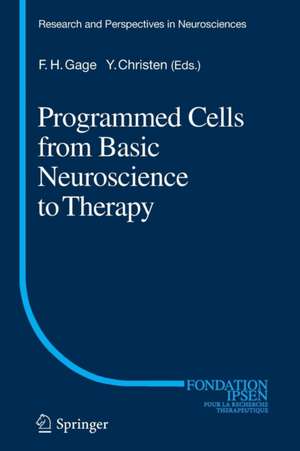Programmed Cells from Basic Neuroscience to Therapy: Research and Perspectives in Neurosciences, cartea 20
Editat de Fred H. Gage, Yves Christenen Limba Engleză Paperback – oct 2016
Din seria Research and Perspectives in Neurosciences
- 18%
 Preț: 944.99 lei
Preț: 944.99 lei - 18%
 Preț: 938.83 lei
Preț: 938.83 lei - 18%
 Preț: 941.68 lei
Preț: 941.68 lei - 18%
 Preț: 1218.21 lei
Preț: 1218.21 lei - 18%
 Preț: 945.92 lei
Preț: 945.92 lei - 5%
 Preț: 1403.44 lei
Preț: 1403.44 lei - 18%
 Preț: 1215.70 lei
Preț: 1215.70 lei - 5%
 Preț: 711.72 lei
Preț: 711.72 lei - 18%
 Preț: 944.36 lei
Preț: 944.36 lei - 18%
 Preț: 936.95 lei
Preț: 936.95 lei - 18%
 Preț: 944.19 lei
Preț: 944.19 lei - 15%
 Preț: 638.89 lei
Preț: 638.89 lei - 18%
 Preț: 945.62 lei
Preț: 945.62 lei - 15%
 Preț: 636.63 lei
Preț: 636.63 lei - 15%
 Preț: 636.63 lei
Preț: 636.63 lei - 18%
 Preț: 886.62 lei
Preț: 886.62 lei - 15%
 Preț: 635.47 lei
Preț: 635.47 lei - 15%
 Preț: 636.30 lei
Preț: 636.30 lei - 15%
 Preț: 635.65 lei
Preț: 635.65 lei - 15%
 Preț: 636.12 lei
Preț: 636.12 lei - 24%
 Preț: 734.67 lei
Preț: 734.67 lei -
 Preț: 422.31 lei
Preț: 422.31 lei - 5%
 Preț: 517.17 lei
Preț: 517.17 lei
Preț: 937.41 lei
Preț vechi: 1143.18 lei
-18% Nou
Puncte Express: 1406
Preț estimativ în valută:
179.37€ • 187.28$ • 148.45£
179.37€ • 187.28$ • 148.45£
Carte tipărită la comandă
Livrare economică 05-19 aprilie
Preluare comenzi: 021 569.72.76
Specificații
ISBN-13: 9783662512944
ISBN-10: 3662512947
Pagini: 142
Ilustrații: XII, 130 p. 14 illus., 13 illus. in color.
Dimensiuni: 155 x 235 x 8 mm
Greutate: 0.21 kg
Ediția:Softcover reprint of the original 1st ed. 2013
Editura: Springer Berlin, Heidelberg
Colecția Springer
Seria Research and Perspectives in Neurosciences
Locul publicării:Berlin, Heidelberg, Germany
ISBN-10: 3662512947
Pagini: 142
Ilustrații: XII, 130 p. 14 illus., 13 illus. in color.
Dimensiuni: 155 x 235 x 8 mm
Greutate: 0.21 kg
Ediția:Softcover reprint of the original 1st ed. 2013
Editura: Springer Berlin, Heidelberg
Colecția Springer
Seria Research and Perspectives in Neurosciences
Locul publicării:Berlin, Heidelberg, Germany
Cuprins
Nuclear reprogramming by eggs and oocytes and eventual prospects of cell replacement therapy.- iPS technology and disease research: issues to be resolved.- ES and iPS cells as tools for modeling human aging .-Characterizing neural circuitry with programmed human neurons.- Direct conversion of fibroblasts to neuronal cells.- Human pluripotent stem cells as tools for modelling neurodegeneration.- From Rett syndrome to classical autism: modeling autism spectrum disorders using human neurons.- Testing evolutionary principles in a dish using embryonic stem cells: the example of the Huntington's Disease gene.- Using stem cells to discover therapeutic targets in ALS and SMA .- Using stem cells to understand and treat Alzheimer's disease.- Using pluripotent stem cells to decipher mechanisms and identify treatments for diseases that affect the brain.- Modeling neural development and disease in human pluripotent stem cells.- Subject index.
Textul de pe ultima copertă
The recent advances in Programming Somatic Cell (PSC) including induced Pluripotent Stem Cells (iPS) and Induced Neuronal phenotypes (iN), has changed the experimental landscape and opened new possibilities. The advances in PSC have provided an important tool for the study of human neuronal function as well as neurodegenerative and neurodevelopmental diseases in live human neurons in a controlled environment. For example, reprogramming cells from patients with neurological diseases allows the study of molecular pathways particular to specific subtypes of neurons such as dopaminergic neurons in Parkinson’s Disease, Motor neurons for Amyolateral Sclerosis or myelin for Multiple Sclerosis. In addition, because PSC technology allows for the study of human neurons during development, disease-specific pathways can be investigated prior to and during disease onset. Detecting disease-specific molecular signatures in live human brain cells, opens possibilities for early intervention therapies and new diagnostic tools. Importantly, it is now feasible to obtain gene expression profiles from neurons that capture the genetic uniqueness of each patient. Importantly, once the neurological neural phenotype is detected in vitro, the so-called “disease-in-a-dish” approach allows for the screening of drugs that can ameliorate the disease-specific phenotype. New therapeutic drugs could either act on generalized pathways in all patients or be patient-specific and used in a personalized medicine approach. However, there are a number of pressing issues that need to be addressed and resolved before PSC technology can be extensively used for clinically relevant modeling of neurological diseases.
Caracteristici
Presents latest research on neurodegenerative diseases Presents prospects for novel therapies Written by leading experts in the field ? Includes supplementary material: sn.pub/extras
